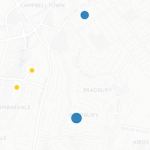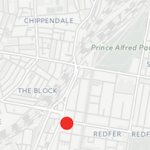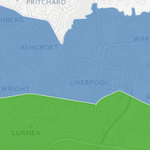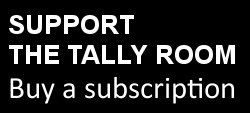12:10am – Last comment from me, a summary of the state of the race in the nine biggest councils:
- Blacktown – Labor has regained its majority on Blacktown council, winning at least nine seats, and possibly ten. No independents will be elected, with 5-6 Liberals filling the remaining seats.
- Sutherland – The Liberal Party has lost its majority. They will need one extra vote for a governing majority, and will likely rely on Steve Simpson, who was a Liberal until recently.
- Fairfield – This council remains up in the air, with the mayoralty a close race between Labor’s Del Bennett and the incumbent Frank Carbonne. Labor has won at least five out of twelve council seats, and could win as many as seven. Carbonne’s independent ticket (along with Dai Le) has won at least two council seats, but could win as many as four. So this council could see Bennett at the head of an enlarged Labor majority, or Carbonne as mayor of a divided council, with a bloc of five Labor councillors and five members of the Carbonne/Le group.
- Sydney – Clover Moore has thoroughly seen off the challenge to her leadership. Her group looks likely to win six council seats (not counting her mayoral seat). Labor and Liberal have each retained one seat. The last seat is a race between conservative independent Angela Vithoulkas and the Greens’ Lindsay Johnston. There’s a lot more Liberal preferences than Labor preferences, and Vithoulkas should benefit from late counting, so it seems likely the Greens will be wiped out.
- Liverpool – Labor’s Wendy Waller looks set to be re-elected as mayor. Labor will need the vote of one of the two members of the Liverpool Community Independents Team for a working majority.
- Penrith – Labor has rebounded from four to seven seats, but will need the support of an independent to have a working majority. They can choose between longstanding independent Jim Aitken, right-wing ex-Liberal Marcus Cornish, or possibly the Greens’ Michelle Tormey or longstanding independent Kevin Crameri, if either of them wins the final seat in the north ward.
- Lake Macquarie – Labor has won a majority on the council, and strengthened their hold on the mayoralty, while the centre-left Independent Lake Alliance has dropped to a new low.
- Campbelltown – Labor has rebounded, winning seven of fifteen seats. Labor will have a number of options for a working majority, including the Greens’ Ben Moroney and independent Fred Borg.
And with that, I’ll call an end to this liveblog.
12:06am – Okay, some final thoughts and I’ll check out.
Labor are big winners from tonight. Labor has regained control of Blacktown and Campbelltown councils, while winning majorities in Lake Macquarie and Cessnock. Labor has bounced back in Penrith and Liverpool, although they will have tenuous working majorities. The Liberal Party went backwards in most of these councils, and also lost their majority in Sutherland. Labor’s biggest black mark was in Fairfield, but even there they may well strengthen their majority.
Clover Moore is a big local winner, holding on against targeted legislation to remove her. Moore has strengthened her majority, squeezing out the other parties.
The result is mixed for the Greens. They haven’t done particularly well in the big eight councils, only winning a seat in Campbelltown, where the quota is very low. Losing their sole seat in the City of Sydney will be disappointing – the party has been made effectively redundant by Clover Moore. The other big council where the Greens should have had a good chance of winning seats was Lake Macquarie, where an unforced error saw the party fail to successfully nominate candidates. It was always going to be very difficult for the Greens to win seats on councils like Fairfield, Liverpool, Blacktown, Sutherland or even Penrith, but in most of these places the Greens haven’t moved any closer to winning.
But the Greens have had some very good results, strengthening their hold in Byron and doing very well in Shoalhaven, and winning seats on councils like Kyogle and Albury.
11:51pm – Some general thoughts: this year has been bad for independents in major urban councils. Independents went backwards significantly in Lake Macquarie, where they used to govern. Less independents will be elected in Penrith and Cessnock, while Sutherland is now overwhelmingly dominated by parties. Labor has emerged on Shoalhaven council along with a bigger bloc of Greens, while no independents look likely to win in Blacktown. Campbelltown council’s system allows for broad diversity, but we’re seeing minor parties displace independents. One longstanding independent looks set to lose her seat to the Christian Democratic Party, while another independent elected in 2012 joined Labor.
Fairfield is the most obvious exception to this rule, with both major parties splintering off into effectively a third party of independents.
11:45pm – In 2012, Labor fell short of a majority in Cessnock, winning five of twelve council seats plus the mayoralty. They’ve regained that majority, winning seven council seats plus the mayoralty. The Liberal Party has held on to their three seats. The previous council included one Green and three independents. The Greens won’t be returning to Cessnock in the next term, while only two independents have held on.
11:33pm – Well Shoalhaven is interesting. I wish I had been able to do coverage of the next most populous council up for election, after the eight I did cover. The current council includes three members of the Shoalhaven Independents Group, one Green, and nine independents including incumbent mayor and former federal Liberal MP Joanna Gash. The new council will include five members of SIG, three Greens (with a full quota in all three wards), one Labor and three members of Gash’s team.
The mayoral race is even more interesting. Joanna Gash leads on 36.5%, followed by the Greens’ Amanda Findley on 33.7% and SIG’s Greg Watson on 29.8%. I’m told that Watson’s preferences favour Findley. If this takes place, Findley will become the third directly-elected Greens mayor after Jan Barham and Simon Richardson (both from Byron), but for a council three times the size of Byron.
11:28pm – Some other councils I haven’t covered:
- Hawkesbury – the Liberal Party has lost their fifth seat, while Labor has gained a second seat and the Greens have held on to their seat. The other five seats remain held by independents, and I’m not across their political persuasion. A referendum on introducing wards to Hawkesbury Council was overwhelmingly defeated.
- Byron – the Greens had been reduced to two councillors (in addition to the mayor’s seat) in 2012. This time the Greens have polled almost four full quotas. If they had run a bigger ticket, they would have won a majority. But they only ran four candidates, and one of those will be disqualified as he will be elected mayor. So a full quota of Greens votes will flow as preferences, presumably helping elect other progressive candidates.
11:08pm – In addition to holding on to the Lake Macquarie mayoralty with an increased vote, Labor has also won an additional council seat. The party won five council seats in 2012, they’ve increased this to six in 2016, which combined with the mayor’s vote gives them a majority. The Liberal Party has held on to their three seats: one in each ward. The Independent Lake Alliance, who dominated the council before the 2012 election, has been further diminished. The alliance held on to four seats in 2012, but could win as few as one, with the far-right Lake Macquarie Independents challenging the Alliance for their seats in two wards.
The Lake Macquarie Independents candidates have polled around 0.85 quotas in the east and north wards, ahead of the Independent Lake Alliance candidates on around 0.74 quotas. There is 0.4 quotas of Labor surplus in the north ward, and 0.2 quotas in the east ward – if those votes flow to the ILA they could hold on to these two seats, but it will be uphill. The ILA has definitely lost their second council seat in their west ward stronghold.
10:53pm – While Labor is struggling to win the Fairfield mayoralty, they could well win a majority on the council. Labor has won five seats, the Liberal Party has won two, and prominent councillors Dai Le and Frank Carbonne have been re-elected as councillors. Carbonne’s seat will pass on to his running mate, former state Liberal MP Andrew Rohan, if he wins the mayoralty. There is one seat up for grabs in each ward.
In Cabravale ward, the race is between the first Liberal and independent Kevin Lam, with an outside chance for sitting independent councillor Nhan Tran. In Fairfield ward, the last seat is a race between Labor and Charbel Saliba, an ex-Liberal councillor running on the Carbonne/Le independent ticket. In Parks ward, the last seat is a race between Labor and Frank Carbonne’s second candidate (or third, if Carbonne wins the mayoralty).
If things go Labor’s way, they could win seven out of twelve councillors. If they don’t, the Carbonne/Le ticket could win third and fourth seats, possibly giving them five if Carbonne wins the mayoralty.
10:36pm – We now have a majority of the vote counted in Campbelltown, which consists of fifteen councillors elected to cover the whole council (no wards). Labor has gained a sixth and seventh seat (although they gained a sixth councillor in the last term after an independent councillor joined the party). The Liberal Party have held on to three of their four seats, while the Greens have returned to the council. Independents Paul Lake, Fred Borg and Bob Thompson also look set to be re-elected. The last seat appears to be a race between the lead Christian Democratic Party candidate (0.59 quotas), the second candidate on Fred Borg’s ticket (0.52 quotas) with longstanding independent Sue Dobson trailing on 0.47 quotas. In addition to the Liberal Party losing their fourth seat, and Dobson possibly losing her seat, Liberal Democrat councillor Clinton Mead has fallen far short.
Labor’s only allies in the last council were those elected on Fred Borg’s ticket, but presumably they will also have the support of the Greens. This means the centre-left coalition will hold 9-10 seats on the new council.
10:29pm – I’ve avoided the results for council for Fairfield, Penrith and Lake Macquarie because they require some data entry to make sense. Let’s now look at Penrith.
In 2012, Liberal independents won six seats, while Labor won four, out of a total of fifteen. Labor appears to have gained an extra seat in all three wards, giving them a total of seven. The Liberal Party has held on to five of their seats. Independents Jim Aitken and Marcus Cornish (an ex-Liberal) have also held on to their seats. The last seat in the north ward is a race between second Liberal Glenn Gardiner (0.6861 quotas), sitting independent councillor Kevin Crameri (0.6824) with an outside shot for sitting Greens councillor Michelle Tormey (0.5461). So while Labor looks set to bounce back, they will need the support of Aitken, Cornish or possibly Crameri or Tormey to hold a majority,
10:13pm – In Liverpool, Labor’s Wendy Waller has extended her lead and looks likely to win. Labor and Liberal will each win two seats in each of the two wards, along with the Liverpool Community Independents Team winning a seat in each ward. If Waller wins the mayoralty, this leaves Labor one seat short of a majority. This is similar to the situation from 2008 until 2012, when Labor held the mayoralty but a coalition of Liberals and three independents effectively ran the shop. The LCIT held the balance of power in 2008-12 and favoured the Liberals, but their incumbent councillor has fallen out with the Liberals in the last term.
10:03pm – Let’s look at Blue Mountains. Labor has won 5 seats, the Liberal Party has won at least three, along with one independent and one Green. In Ward 2, the last two seats are in play. Labor is on 1.5 quotas, while the Liberal Party and independent Rob Thompson are both around 0.86 quotas. The Greens trail on 0.74 quotas. If the Greens have benefited from preferences, they have a chance of overtaking the Liberal or Thompson.
9:58pm – I’ve got some requests for information about other councils. In Camden, the Liberal Party won five seats in 2012, alongside four independents. This was the first time the Liberal Party had run a solid campaign. This time Labor has joined them, and Camden looks set to become another partisan council. The Liberal Party is on track for four seats, along with three Labor and two independents: Eva Campbell and Scott Metcalfe. CORRECTION: most of the votes for Metcalfe’s ticket are votes for his running mate Robert Mills below the line, so Mills looks likely to win.
9:49pm – I haven’t had time to look at other results going on. The Northern Star has good coverage of the results in the north coast, and regular commenter Nick Casmirri has been tweeting a variety of results.
9:39pm – Looking at the council results for the City of Sydney, Clover Moore appears to have won her largest council majority. With about 14% of the vote counted, Moore’s team has won at least five seats, with Liberal and Labor each winning a seat. The last two seats appear to be a race between Moore’s sixth candidate, the second Liberal and independent Angela Vithoulkas. Ex-Liberal Edward Mandla (running second on Vithoulkas’ ticket) has lost his seat and the Greens appear to have lost their seat after three terms on the council.
9:22pm – Let’s look at Sutherland Shire. It looks like the Liberal Party has lost their majority, and will need to work with independent Steve Simpson, who was a Liberal prior to losing preselection before this election. The Liberal Party won nine out of fifteen seats in 2012, and that increased to eleven during the last term. The A and C wards have cleanly split as 2 Liberal, 1 Labor. Labor has won two out of three in D ward. In B ward, the second Labor candidate is narrowly behind the second Liberal for the final seat, but there is 12.6% of the vote in Greens preferences, so that will likely see Labor win. That would give Labor and Liberal 6 seats each.
In E ward, the Liberal Party and independent ex-Liberal Steve Simpson have both won a seat, with the final seat a race between Labor and the last remaining Shire Watch independent Peter Towell. This looks likely to give us a council of seven Liberals, six-seven Labor, one ex-Liberal independent and possibly one other independent. In this situation, the Liberal Party would need to work with Simpson to govern.
8:40pm – Labor is clearly on track to win a majority on Blacktown council, possibly with as many as ten out of fifteen seats. In Ward 1 (currently represented by 2 Liberals and 1 Labor), the second Labor is about 3% ahead of the second Liberal for the last seat. That would be one seat gain. In Ward 2 (also covered by 2 Liberals and 1 Labor), the Liberal Party is down to just 1.1 quotas, with Labor leading for the last seat with 1.6 quotas. In the third ward, Labor is on almost two quotas, with the first Liberal and independent Russ Dickens competing for the final seat. In Ward 4, Labor is well over two quotas, with the Liberal Party on one. This leaves independent ex-Liberal Jacqueline Donaldson stranded on just over 30% of a quota. If these results hold, Labor will hold ten seats and the Liberal Party five.
8:17pm – Labor is solidifying their hold on the Lake Macquarie mayoralty. Labor’s Kay Fraser is on 45.25% (up 12.4%), ahead of the ILA’s Laurie Coghlan on 20% (down 5.5%) and Liberal Jason Pauling on 19.95% (down 2.4%). We don’t know much about the council results, but this suggests Labor’s position will be stronger.
8:14pm – With roughly one quarter of the vote in for the Fairfield mayoral vote, Labor’s Del Bennett leads on 31.95%, followed by Labor-turned-independent mayor Frank Carbone on 28.3%, with Liberal-turned-independent councillor Dai Le on 17.2% and official Liberal candidate Joe Molluso on 12.4%. This means the two Liberals will decide which of the Labor candidates will win the mayoralty. Dai Le preferenced Carbone explicitly – the two candidates ran an integrated campaign with similar how-to-votes, and you’d expect her preferences to favour Carbone, making him the favourite. We won’t know a result tonight.
8:07pm – We have a very small sample from Campbelltown council – their council ballot is quite large and will take time to count, but it appears that the Labor vote is up substantially and the Liberal vote is down substantially, which will likely put Labor in a leading position in forming a majority coalition.
8:04pm – With 16% of the vote counted in the Liverpool mayoral race, the Liberal Party’s Tony Hadchiti is on 33.6% (a swing of over 10% away from the Liberal Party) while Labor’s Wendy Waller is on 36.7%, which is a swing of almost 7%. Not clear if that’s enough for Labor to win, but a big improvement. There was a jump in the vote for the Liverpool Community Independents Team candidate, up from 6% to 10%. We have very little from the council, but if those numbers are accurate the Liberal Party would be worried about losing a seat in each ward, plus the mayoralty.
8:00pm – Numbers are very small in the four other Blacktown wards, but in Ward 1 we have results from ten out of 19 ordinary booths. This is the best ward for the Liberal Party, and they hold two seats in the ward. There has been a 4% swing to Labor and away from the Liberal Party. The Liberal Party’s second candidate is on 0.74 quotas, just ahead of Labor’s second candidate on 0.63 quotas. If Labor can gain this seat and hold all their others, they will win a majority on the council.
7:52pm – So we have about 19.4% of enrolled votes cast so far in the City of Sydney and Clover Moore is on almost 59.4% of the primary vote. That’s a swing of over 8% towards Moore. The Liberal Party’s Christine Forster is on just under 17%, a swing of 1%. Labor’s Linda Scott is on 10%, which roughly what she got in 2012. Angela Vithoulkas’ vote is down from 9.8% to 7.9%. The Greens’ Lindsay Johnston is on 5.3%, which is down from 6.6% in 2012 and over 13% in 2008.
7:44pm – Apologies for the absence – I’ve just come from the Giants-Swans game and am now going to get into the results as we have them.
6:00pm – Polls have just closed. I’ll be joining you in about an hour to track the results in some of the biggest councils.
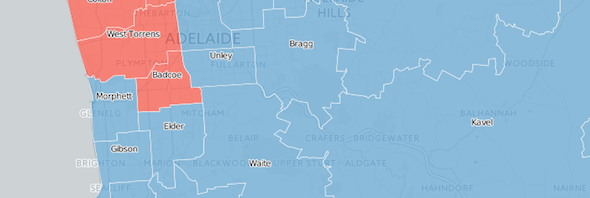 While we were all recovering from the federal election, South Australia was undergoing a redrawing of its state electoral map for the 2018 state election. The draft electoral map was released in mid-August, and I blogged about the underlying statistics driving the redistribution at the time.
While we were all recovering from the federal election, South Australia was undergoing a redrawing of its state electoral map for the 2018 state election. The draft electoral map was released in mid-August, and I blogged about the underlying statistics driving the redistribution at the time. Coverage of local council elections understandably focus on local stories, but this can make it hard to get a broad perspective on how an election has gone. A poor result in one high-profile council doesn’t necessarily mean that party has done poorly in most places they have run, and it’s always possible to focus on success stories over failures. Most frustratingly, council stories are rarely in proportion to the sizes of councils. I’ve tried to remedy this by focusing on the eight most populous councils, most of which are in Western Sydney.
Coverage of local council elections understandably focus on local stories, but this can make it hard to get a broad perspective on how an election has gone. A poor result in one high-profile council doesn’t necessarily mean that party has done poorly in most places they have run, and it’s always possible to focus on success stories over failures. Most frustratingly, council stories are rarely in proportion to the sizes of councils. I’ve tried to remedy this by focusing on the eight most populous councils, most of which are in Western Sydney.